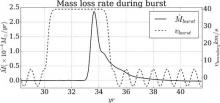
Abstract
We investigate mass transfer and the formation of disc in binary systems using a combination of numerical simulations and theory. We consider six models distinguished by binary separation, secondary mass and outflow mechanisms. Each system consists of an asymptotic-giant-branch (AGB) star and an accreting secondary. The AGB star loses its mass via a wind. In one of our six models, the AGB star incurs a short period of outburst. In all cases, the secondary accretes part of the ejected mass and also influences the mass-loss rate of the AGB star. The ejected mass may remain gravitationally bound to the binary system and form a circumbinary disk, or contribute to an accretion disk around the secondary. In other cases, the ejecta will escape the binary system. The accretion rate on to the secondary changes non-linearly with binary separation. In our closest binary simulations, our models exemplify the wind Roche lobe overflow while in our wide binary cases, the mass transfer exhibits Bondi-Hoyle accretion. The morphologies of the outflows in the binary systems are varied. The variety may provide clues to how the late AGB phase influences planetary nebulae shaping. We employ the adaptive-mesh-refinement code ASTROBEAR for our simulations and include ray-tracing, radiation transfer, cooling and dust formation. To attain the highest computational efficiency and the most stable results, all simulations are run in the corotating frame.